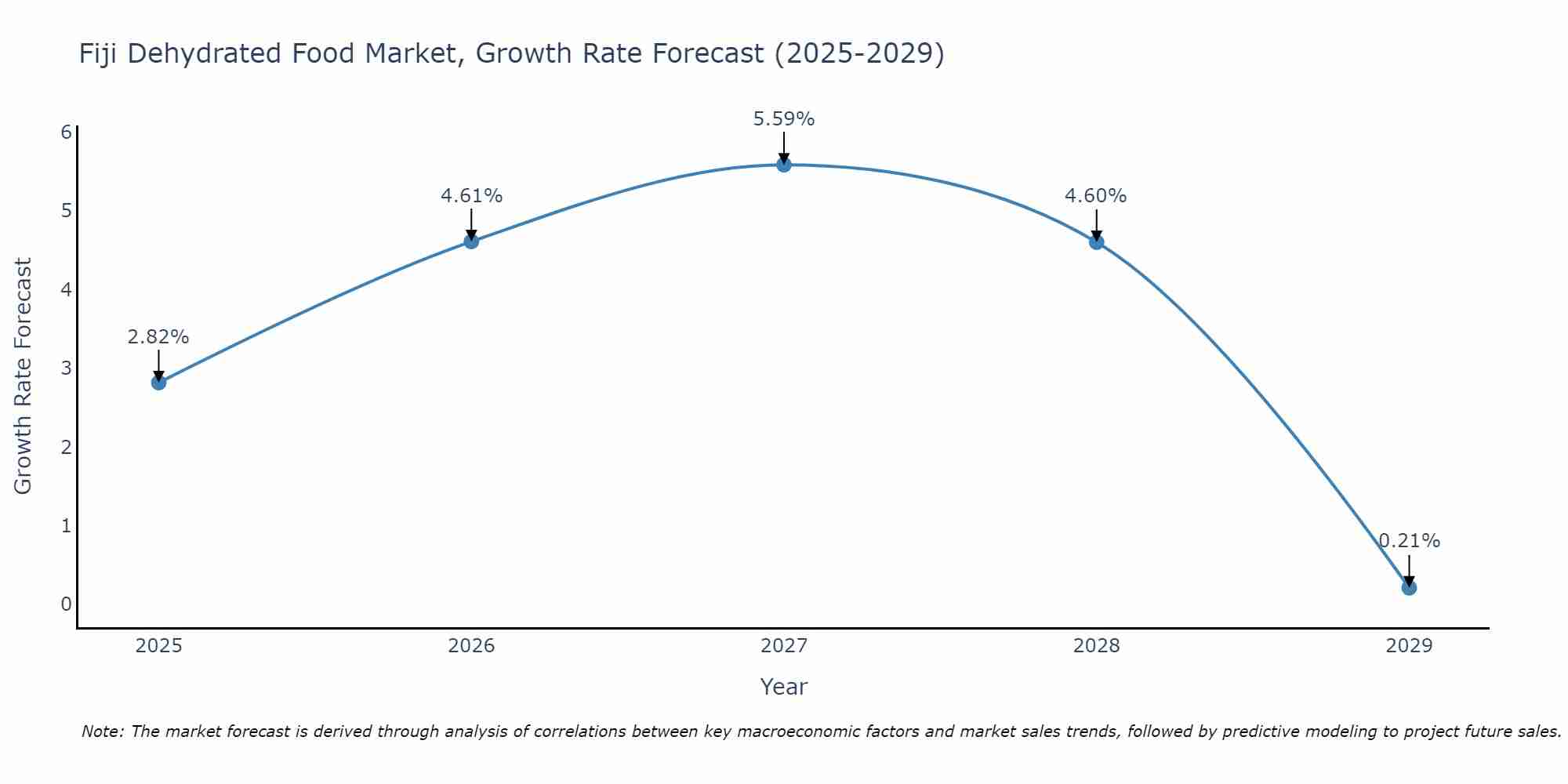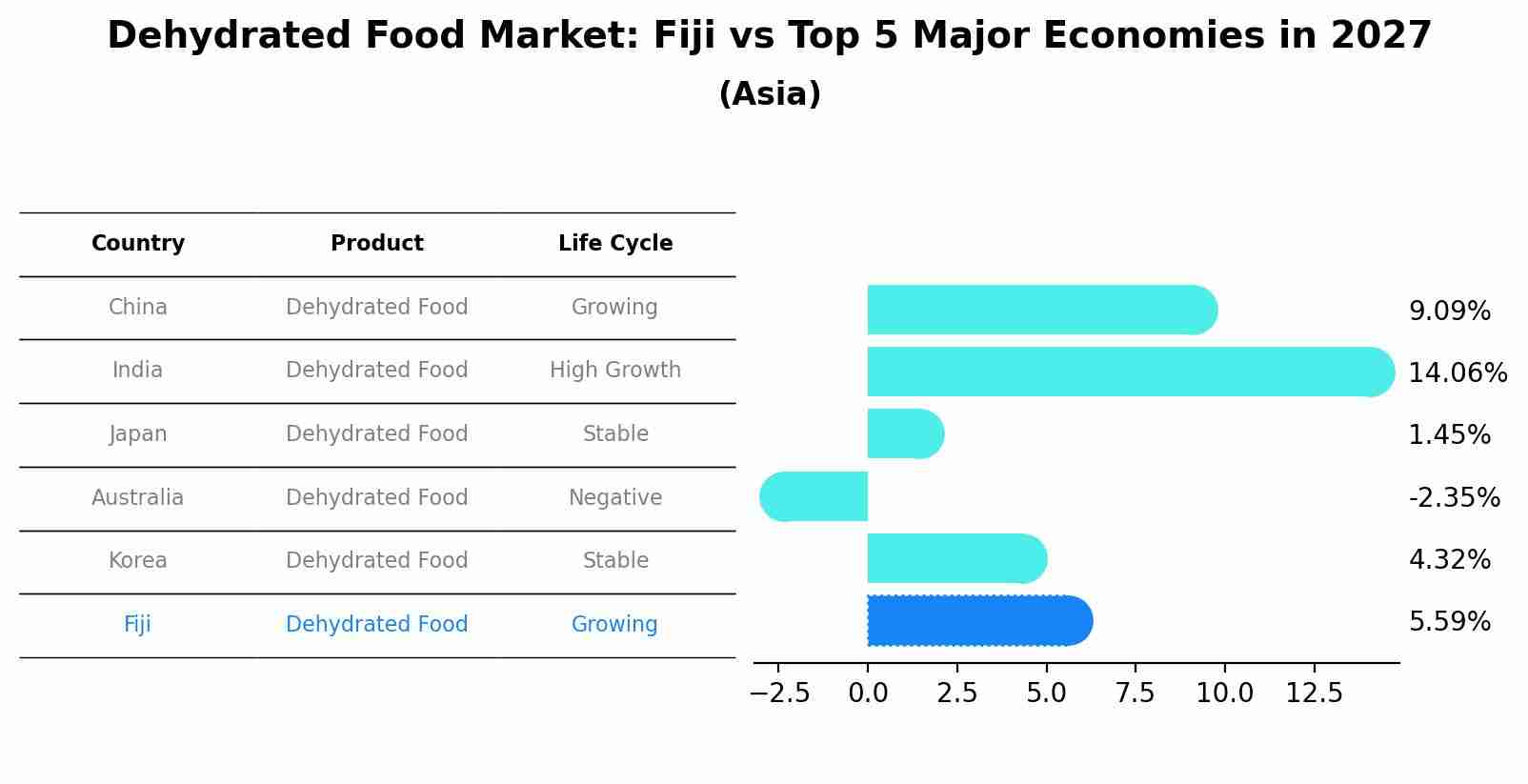Fiji Dehydrated Food Market (2025-2031) | Share, Revenue, Analysis, Forecast, Outlook, Companies, Size, Segmentation, Growth, Value, Industry & Trends
| Product Code: ETC4837244 | Publication Date: Nov 2023 | Updated Date: Apr 2025 | Product Type: Market Research Report | |
| Publisher: 6Wresearch | Author: Sachin Kumar Rai | No. of Pages: 60 | No. of Figures: 30 | No. of Tables: 5 |
Fiji Dehydrated Food Market Size Growth Rate
The Fiji Dehydrated Food Market is projected to witness mixed growth rate patterns during 2025 to 2029. Growth accelerates to 5.59% in 2027, following an initial rate of 2.82%, before easing to 0.21% at the end of the period.

Dehydrated Food Market: Fiji vs Top 5 Major Economies in 2027 (Asia)
The Dehydrated Food market in Fiji is projected to grow at a growing growth rate of 5.59% by 2027, within the Asia region led by China, along with other countries like India, Japan, Australia and South Korea, collectively shaping a dynamic and evolving market environment driven by innovation and increasing adoption of emerging technologies.

Fiji Dehydrated Food Market Overview
The Dehydrated Food Market in Fiji focuses on food products that have been preserved through the process of removing moisture. This market includes products like dried fruits, vegetables, and meals that offer convenience and extended shelf life. The growing demand for ready-to-eat meals, as well as the popularity of outdoor activities and tourism, is fueling the growth of the dehydrated food market in Fiji.
Drivers of the market
The growing demand for convenience foods and long shelf-life products in Fiji is driving the dehydrated food market. Dehydrated foods offer extended shelf life, reduced transportation costs, and ease of storage, making them ideal for both consumers and businesses. As the preference for quick and easy meal options grows, dehydrated foods, particularly vegetables, fruits, and ready-to-eat meals, are gaining popularity in Fiji. The increasing interest in emergency preparedness and disaster relief efforts is also contributing to the demand for dehydrated food products.
Challenges of the market
The Fiji dehydrated food market faces challenges related to high import costs and limited local production capacity. Most dehydrated food products are imported, which increases the overall cost for consumers and businesses. Additionally, there is a lack of awareness about the benefits of dehydrated foods, which hinders consumer adoption. The small size of the local market and the reliance on external suppliers make the market vulnerable to fluctuations in international shipping costs, further affecting product availability and pricing.
Government Policy of the market
Fijis government supports the dehydrated food industry to enhance food security and promote exports. Policies focus on subsidizing equipment for dehydration processes and providing grants to small-scale producers. Export incentives are also offered to encourage local businesses to access international markets. The government emphasizes the importance of food safety standards and certifications to meet global trade requirements.
Key Highlights of the Report:
- Fiji Dehydrated Food Market Outlook
- Market Size of Fiji Dehydrated Food Market, 2024
- Forecast of Fiji Dehydrated Food Market, 2031
- Historical Data and Forecast of Fiji Dehydrated Food Revenues & Volume for the Period 2021-2031
- Fiji Dehydrated Food Market Trend Evolution
- Fiji Dehydrated Food Market Drivers and Challenges
- Fiji Dehydrated Food Price Trends
- Fiji Dehydrated Food Porter`s Five Forces
- Fiji Dehydrated Food Industry Life Cycle
- Historical Data and Forecast of Fiji Dehydrated Food Market Revenues & Volume By Type for the Period 2021-2031
- Historical Data and Forecast of Fiji Dehydrated Food Market Revenues & Volume By Spray-dried for the Period 2021-2031
- Historical Data and Forecast of Fiji Dehydrated Food Market Revenues & Volume By Freeze-dried for the Period 2021-2031
- Historical Data and Forecast of Fiji Dehydrated Food Market Revenues & Volume By Vacuum-dried for the Period 2021-2031
- Historical Data and Forecast of Fiji Dehydrated Food Market Revenues & Volume By Drum-dried for the Period 2021-2031
- Historical Data and Forecast of Fiji Dehydrated Food Market Revenues & Volume By Others for the Period 2021-2031
- Historical Data and Forecast of Fiji Dehydrated Food Market Revenues & Volume By Product for the Period 2021-2031
- Historical Data and Forecast of Fiji Dehydrated Food Market Revenues & Volume By Dried Processed Food for the Period 2021-2031
- Historical Data and Forecast of Fiji Dehydrated Food Market Revenues & Volume By Dried Fruit & Vegetable for the Period 2021-2031
- Historical Data and Forecast of Fiji Dehydrated Food Market Revenues & Volume By Dried Dairy for the Period 2021-2031
- Historical Data and Forecast of Fiji Dehydrated Food Market Revenues & Volume By Dried Meat & Seafood for the Period 2021-2031
- Historical Data and Forecast of Fiji Dehydrated Food Market Revenues & Volume By Others for the Period 2021-2031
- Historical Data and Forecast of Fiji Dehydrated Food Market Revenues & Volume By Distribution Channel for the Period 2021-2031
- Historical Data and Forecast of Fiji Dehydrated Food Market Revenues & Volume By Hypermarket/Supermarket for the Period 2021-2031
- Historical Data and Forecast of Fiji Dehydrated Food Market Revenues & Volume By Convenience Stores for the Period 2021-2031
- Historical Data and Forecast of Fiji Dehydrated Food Market Revenues & Volume By Online Retailing for the Period 2021-2031
- Historical Data and Forecast of Fiji Dehydrated Food Market Revenues & Volume By Others for the Period 2021-2031
- Fiji Dehydrated Food Import Export Trade Statistics
- Market Opportunity Assessment By Type
- Market Opportunity Assessment By Product
- Market Opportunity Assessment By Distribution Channel
- Fiji Dehydrated Food Top Companies Market Share
- Fiji Dehydrated Food Competitive Benchmarking By Technical and Operational Parameters
- Fiji Dehydrated Food Company Profiles
- Fiji Dehydrated Food Key Strategic Recommendations
Frequently Asked Questions About the Market Study (FAQs):
1 Executive Summary |
2 Introduction |
2.1 Key Highlights of the Report |
2.2 Report Description |
2.3 Market Scope & Segmentation |
2.4 Research Methodology |
2.5 Assumptions |
3 Fiji Dehydrated Food Market Overview |
3.1 Fiji Country Macro Economic Indicators |
3.2 Fiji Dehydrated Food Market Revenues & Volume, 2021 & 2031F |
3.3 Fiji Dehydrated Food Market - Industry Life Cycle |
3.4 Fiji Dehydrated Food Market - Porter's Five Forces |
3.5 Fiji Dehydrated Food Market Revenues & Volume Share, By Type, 2021 & 2031F |
3.6 Fiji Dehydrated Food Market Revenues & Volume Share, By Product, 2021 & 2031F |
3.7 Fiji Dehydrated Food Market Revenues & Volume Share, By Distribution Channel, 2021 & 2031F |
4 Fiji Dehydrated Food Market Dynamics |
4.1 Impact Analysis |
4.2 Market Drivers |
4.3 Market Restraints |
5 Fiji Dehydrated Food Market Trends |
6 Fiji Dehydrated Food Market Segmentations |
6.1 Fiji Dehydrated Food Market, By Type |
6.1.1 Overview and Analysis |
6.1.2 Fiji Dehydrated Food Market Revenues & Volume, By Spray-dried, 2021-2031F |
6.1.3 Fiji Dehydrated Food Market Revenues & Volume, By Freeze-dried, 2021-2031F |
6.1.4 Fiji Dehydrated Food Market Revenues & Volume, By Vacuum-dried, 2021-2031F |
6.1.5 Fiji Dehydrated Food Market Revenues & Volume, By Drum-dried, 2021-2031F |
6.1.6 Fiji Dehydrated Food Market Revenues & Volume, By Others, 2021-2031F |
6.2 Fiji Dehydrated Food Market, By Product |
6.2.1 Overview and Analysis |
6.2.2 Fiji Dehydrated Food Market Revenues & Volume, By Dried Processed Food, 2021-2031F | 6.2.3 Fiji Dehydrated Food Market Revenues & Volume, By Dried Fruit & Vegetable, 2021-2031F |
6.2.4 Fiji Dehydrated Food Market Revenues & Volume, By Dried Dairy, 2021-2031F |
6.2.5 Fiji Dehydrated Food Market Revenues & Volume, By Dried Meat & Seafood, 2021-2031F |
6.2.6 Fiji Dehydrated Food Market Revenues & Volume, By Others, 2021-2031F |
6.3 Fiji Dehydrated Food Market, By Distribution Channel |
6.3.1 Overview and Analysis |
6.3.2 Fiji Dehydrated Food Market Revenues & Volume, By Hypermarket/Supermarket, 2021-2031F |
6.3.3 Fiji Dehydrated Food Market Revenues & Volume, By Convenience Stores, 2021-2031F |
6.3.4 Fiji Dehydrated Food Market Revenues & Volume, By Online Retailing, 2021-2031F |
6.3.5 Fiji Dehydrated Food Market Revenues & Volume, By Others, 2021-2031F |
7 Fiji Dehydrated Food Market Import-Export Trade Statistics |
7.1 Fiji Dehydrated Food Market Export to Major Countries |
7.2 Fiji Dehydrated Food Market Imports from Major Countries |
8 Fiji Dehydrated Food Market Key Performance Indicators |
9 Fiji Dehydrated Food Market - Opportunity Assessment |
9.1 Fiji Dehydrated Food Market Opportunity Assessment, By Type, 2021 & 2031F |
9.2 Fiji Dehydrated Food Market Opportunity Assessment, By Product, 2021 & 2031F |
9.3 Fiji Dehydrated Food Market Opportunity Assessment, By Distribution Channel, 2021 & 2031F |
10 Fiji Dehydrated Food Market - Competitive Landscape |
10.1 Fiji Dehydrated Food Market Revenue Share, By Companies, 2024 |
10.2 Fiji Dehydrated Food Market Competitive Benchmarking, By Operating and Technical Parameters |
11 Company Profiles |
12 Recommendations | 13 Disclaimer |
- Single User License$ 1,995
- Department License$ 2,400
- Site License$ 3,120
- Global License$ 3,795
Search
Related Reports
- Portugal Electronic Document Management Market (2025-2031) | Strategy, Consumer Insights, Analysis, Investment Trends, Opportunities, Growth, Size, Share, Industry, Revenue, Segments, Value, Segmentation, Supply, Forecast, Restraints, Outlook, Competition, Drivers, Trends, Demand, Pricing Analysis, Competitive, Strategic Insights, Companies, Challenges
- France Electronic Document Management Market (2025-2031) | Strategy, Consumer Insights, Analysis, Investment Trends, Opportunities, Growth, Size, Share, Industry, Revenue, Segments, Value, Segmentation, Supply, Forecast, Restraints, Outlook, Competition, Drivers, Trends, Demand, Pricing Analysis, Competitive, Strategic Insights, Companies, Challenges
- Portugal Occupational Health & Safety Services Market (2025-2031) | Strategy, Consumer Insights, Analysis, Investment Trends, Opportunities, Growth, Size, Share, Industry, Revenue, Segments, Value, Segmentation, Supply, Forecast, Restraints, Outlook, Competition, Drivers, Trends, Demand, Pricing Analysis, Competitive, Strategic Insights, Companies, Challenges
- Netherlands Occupational Health and Safety Services Market (2025-2031) | Strategy, Consumer Insights, Analysis, Investment Trends, Opportunities, Growth, Size, Share, Industry, Revenue, Segments, Value, Segmentation, Supply, Forecast, Restraints, Outlook, Competition, Drivers, Trends, Demand, Pricing Analysis, Competitive, Strategic Insights, Companies, Challenges
- Belgium and Luxembourg Facility Management Market (2025-2031) | Strategy, Consumer Insights, Analysis, Investment Trends, Opportunities, Growth, Size, Share, Industry, Revenue, Segments, Value, Segmentation, Supply, Forecast, Restraints, Outlook, Competition, Drivers, Trends, Demand, Pricing Analysis, Competitive, Strategic Insights, Companies, Challenges
- Russia Women Intimate Apparel Market (2025-2031) | Strategy, Consumer Insights, Analysis, Investment Trends, Opportunities, Growth, Size, Share, Industry, Revenue, Segments, Value, Segmentation, Supply, Forecast, Restraints, Outlook, Competition, Drivers, Trends, Demand, Pricing Analysis, Competitive, Strategic Insights, Companies, Challenges
- Africa Chocolate Market (2025-2031) | Size, Share, Trends, Growth, Revenue, Analysis, Forecast, industry & Outlook
- Global Hydroxychloroquine And Chloroquine Market (2025-2031) | Industry, Trends, Size, Outlook, Growth, Value, Companies, Revenue, Analysis, Share, Forecast
- Saudi Arabia Plant Maintenance Market (2025-2031) | Industry, Size, Growth, Revenue, Value, Companies, Forecast, Analysis, Share & Trends
- Taiwan Electric Truck Market (2025-2031) | Outlook, Industry, Revenue, Size, Forecast, Growth, Analysis, Share, Companies, Value & Trends
Industry Events and Analyst Meet
Our Clients
Whitepaper
- Middle East & Africa Commercial Security Market Click here to view more.
- Middle East & Africa Fire Safety Systems & Equipment Market Click here to view more.
- GCC Drone Market Click here to view more.
- Middle East Lighting Fixture Market Click here to view more.
- GCC Physical & Perimeter Security Market Click here to view more.
6WResearch In News
- Doha a strategic location for EV manufacturing hub: IPA Qatar
- Demand for luxury TVs surging in the GCC, says Samsung
- Empowering Growth: The Thriving Journey of Bangladesh’s Cable Industry
- Demand for luxury TVs surging in the GCC, says Samsung
- Video call with a traditional healer? Once unthinkable, it’s now common in South Africa
- Intelligent Buildings To Smooth GCC’s Path To Net Zero













